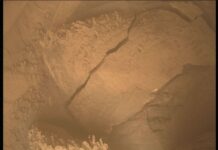NASA and SpaceX Prepare for Europa Clipper Mission to Explore Jupiter’s Icy Moon
NASA, in collaboration with SpaceX, is gearing up for the highly anticipated launch of the Europa Clipper mission. Scheduled to lift off on Thursday, October 10, this mission aims to uncover whether one of Jupiter’s icy moons, Europa, might harbor conditions suitable for life. The spacecraft will embark on its journey aboard a SpaceX Falcon Heavy rocket from Launch Complex 39A at NASA’s Kennedy Space Center in Florida.
Objectives and Scientific Goals
Europa Clipper will carry an array of nine sophisticated instruments and a gravity science experiment designed to gather detailed measurements while orbiting Jupiter and conducting multiple close flybys of its moon, Europa. Current scientific research suggests that beneath Europa’s icy crust lies an ocean with a volume twice that of all Earth’s oceans combined. This mission is a significant leap towards understanding the astrobiological potential of worlds beyond our planet.
The primary scientific objective of the Europa Clipper mission is to determine if there are regions beneath Europa’s surface that could support life. The mission has three main scientific goals:
- Understanding the Ice Shell and Subsurface Ocean: The mission aims to study the thickness and properties of Europa’s ice shell and the characteristics of the subsurface ocean.
- Composition Analysis: Investigating the composition of Europa’s surface and subsurface to understand the chemistry that might support life.
- Geological Activity: Examining the geology of Europa, including its surface features and potential ongoing geological activity.
Media Accreditation and Coverage
Journalists interested in covering the Europa Clipper launch must apply for media accreditation. The deadlines for media accreditation are as follows:
- U.S. citizens representing national or international media must apply by 11:59 p.m. EDT on Friday, September 27.
- International media representatives must submit their applications by 11:59 p.m. EDT on Friday, September 20.
For logistical arrangements such as space for satellite trucks, tents, or electrical connections, media representatives should email ksc-media-accreditat@mail.nasa.gov before October 1. NASA’s media accreditation policy is available online. For accreditation-related inquiries, email ksc-media-accreditat@mail.nasa.gov. For other mission-related questions, contact the Kennedy Space Center press room at 321-867-2468.
For Spanish-language coverage or interviews, contact Antonia Jaramillo at 321-501-8425 or Messod Bendayan at 256-930-1371.
Pre-Launch Media Events
Accredited media will have the opportunity to partake in a series of pre-launch briefings and interviews with key mission personnel, including a briefing during the week of September 9. NASA will provide additional details on the media program as the launch date approaches.
NASA will also post updates on the spacecraft’s launch preparations on the Europa Clipper blog.
Mission Development and Management
The Europa Clipper mission is led by NASA’s Jet Propulsion Laboratory (JPL) in Southern California, managed by Caltech in Pasadena. JPL is responsible for the mission’s development in partnership with the Johns Hopkins Applied Physics Laboratory (APL) in Laurel, Maryland. APL designed the spacecraft’s main body in collaboration with JPL and NASA’s Goddard Space Flight Center in Greenbelt, Maryland. The Planetary Missions Program Office at NASA’s Marshall Space Flight Center in Huntsville, Alabama, manages the Europa Clipper mission’s program execution.
The NASA Launch Services Program, based at Kennedy Space Center, oversees the launch service for the Europa Clipper spacecraft.
Technical Jargon Explained
For those unfamiliar with the technical terms:
- Orbit: The path one object in space takes around another.
- Flybys: When a spacecraft passes close to a celestial body to collect data.
- Instruments: Scientific tools on a spacecraft used to gather data.
- Gravity Science Experiment: A test that measures gravitational fields to infer details about a planet or moon’s interior structure.
Good to Know
The Europa Clipper mission is part of NASA’s broader effort to explore the potential for life beyond Earth. This mission is particularly exciting because Europa, with its subsurface ocean, is considered one of the most promising places to find life in our solar system. The data collected by Europa Clipper will help scientists understand the moon’s ice shell, ocean, and terrain, offering insights that could inform future missions.
Reactions and Reviews
The scientific community has expressed great enthusiasm for the Europa Clipper mission. Astrobiologists and planetary scientists are particularly keen on the mission’s potential to reveal new information about one of the solar system’s most intriguing moons. The possibility of discovering signs of life or conditions that could support life makes this mission a landmark event in space exploration.
Conclusion
The Europa Clipper mission represents a significant step forward in our quest to understand the potential for life beyond Earth. With its sophisticated suite of instruments and ambitious scientific goals, the mission promises to unlock many of Europa’s secrets. As NASA and SpaceX prepare for the October launch, the world will be watching closely, eager to see what discoveries await beneath Europa’s icy surface.
For more details on the mission and launch preparations, visit NASA’s Europa Clipper mission page.
Contact Information
For further information, you can reach out to the following contacts:
- Leejay Lockhart: Kennedy Space Center, Florida, 321-747-8310, leejay.lockhart@nasa.gov
- Karen Fox / Alana Johnson: NASA Headquarters, Washington, 202-358-1600 / 202-358-1501, karen.c.fox@nasa.gov / alana.r.johnson@nasa.gov
- María José Viñas: NASA Headquarters, Washington, 240-458-0248, maria-jose.vinasgarcia@nasa.gov
- Julian Coltre: NASA Headquarters, Washington, 202-358-1100, julian.n.coltre@nasa.gov
This mission is an exciting opportunity to expand our understanding of the cosmos and potentially answer one of humanity’s most profound questions: Are we alone in the universe? Stay tuned for more updates as the launch date approaches.
For more Information, Refer to this article.

































